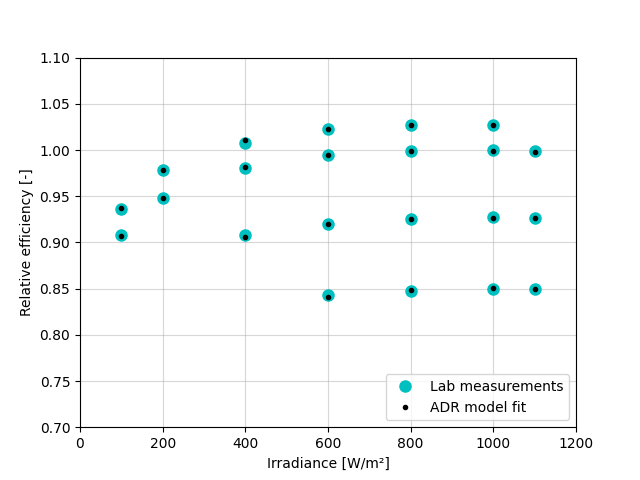Note
Go to the end to download the full example code
Obtaining ADR model parameters from IEC 61853 matrix measurements#
There’s a fitting function provided in pvlib to do exactly that.
Since PV module efficiency varies with irradiance and temperature what better way to train a model than using efficiency measurement over a broad range of temperature and irradiance levels? The standard IEC 61853-1 defines a standard matrix of conditions for such measurements and this example shows how the ADR model parameters can be determined with just a few lines of code using functions in pvlib-python.
Author: Anton Driesse
from io import StringIO
import pandas as pd
import matplotlib.pyplot as plt
from pvlib.pvarray import pvefficiency_adr, fit_pvefficiency_adr
Here are some matrix measurements:
iec61853data = '''
irradiance temperature p_mp
0 100 15.0 30.159
1 200 15.0 63.057
2 400 15.0 129.849
3 600 15.0 197.744
4 800 15.0 264.825
5 1000 15.0 330.862
6 100 25.0 29.250
7 200 25.0 61.137
8 400 25.0 126.445
9 600 25.0 192.278
10 800 25.0 257.561
11 1000 25.0 322.305
12 1100 25.0 354.174
15 400 50.0 117.062
16 600 50.0 177.959
17 800 50.0 238.626
18 1000 50.0 298.954
19 1100 50.0 328.413
23 600 75.0 162.966
24 800 75.0 218.585
25 1000 75.0 273.651
26 1100 75.0 301.013
'''
df = pd.read_csv(StringIO(iec61853data), delim_whitespace=True)
Now calculate the normalized or relative efficiency values and use the fitting function to determine the parameters. The parameters (shown below) can now be used to simulate the module operating in a PV system.
k_a = 0.99924
k_d = -5.49097
tc_d = 0.01918
k_rs = 0.06999
k_rsh = 0.26144
Compare the model output to the original measurements. The chart below shows minor differences but due to their random nature they are most likely evidence of the limitations of measurement accuracy.
eta_rel_adr = pvefficiency_adr(df['irradiance'],
df['temperature'], **adr_params)
plt.figure()
plt.plot(df['irradiance'], df['eta_rel'], 'oc', ms=8)
plt.plot(df['irradiance'], eta_rel_adr, '.k')
plt.legend(['Lab measurements', 'ADR model fit'], loc='lower right')
plt.xlabel('Irradiance [W/m²]')
plt.ylabel('Relative efficiency [-]')
plt.grid(alpha=0.5)
plt.xlim(0, 1200)
plt.ylim(0.7, 1.1)
plt.show()

References#
- 1
A. Driesse and J. S. Stein, “From IEC 61853 power measurements to PV system simulations”, Sandia Report No. SAND2020-3877, 2020. DOI: 10.2172/1615179
- 2
A. Driesse, M. Theristis and J. S. Stein, “A New Photovoltaic Module Efficiency Model for Energy Prediction and Rating,” in IEEE Journal of Photovoltaics, vol. 11, no. 2, pp. 527-534, March 2021. DOI: 10.1109/JPHOTOV.2020.3045677
Total running time of the script: (0 minutes 0.187 seconds)